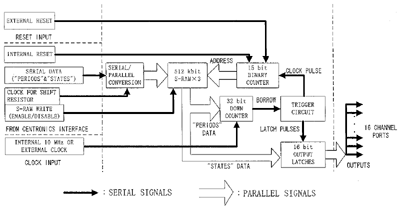
Tomonori TOYODA, Hisashi YOSHIDA, Osamu OISHI and Seiichi MIYAJIMA
[Rev. Sci. Instrum. 68, 3140 (1997)]
Fully-digitized automatic pulse generator for general NMR purposes was designed and constructed [Figure 1]. The following features were realized: (i) Pulse sequence is constructed in a standard 32 bit personal computer rather than on-board microprocessors. (ii) 16 independent channels are controlled by identifying each of the binary states by 16 bit codes. (iii) The single time periods of 0.1 (mu)s to ca. 7 min are obtained in 0.1 (mu)s step by using 10 MHz master clock and 32 bit time data. The period longer than above is obtained by repetition. (iv) To realize the high speed control and high time-resolution, the pulse generator hardware is separated from the host computer. Once the pulse sequence is transferred from the computer to the pulse generator, the pulse sequence is synthesized within the pulse generator hardware, and then output to the main spectrometer console. (v) The hardware consists of basic TTL devices without resorting to custom LSIs. (vi) Centronics printer interface, which is already installed in a commercial personal computer, is used for data transfer. Laboriousness in making a custom interface board or the cost in purchasing the commercial interface boards are thus avoided. On the other hand, a technique is necessary in constructing the pulse sequence data because only 3 bus lines are available for the 16 channel data. The present pulse generator design does not depend on the models of personal computers, and the devices used are readily available worldwide. The present equipment was successfully used for the PGSE anisotropic self-diffusion experiment in liquid crystal.

Figure 1. Block diagram of the pulse generator